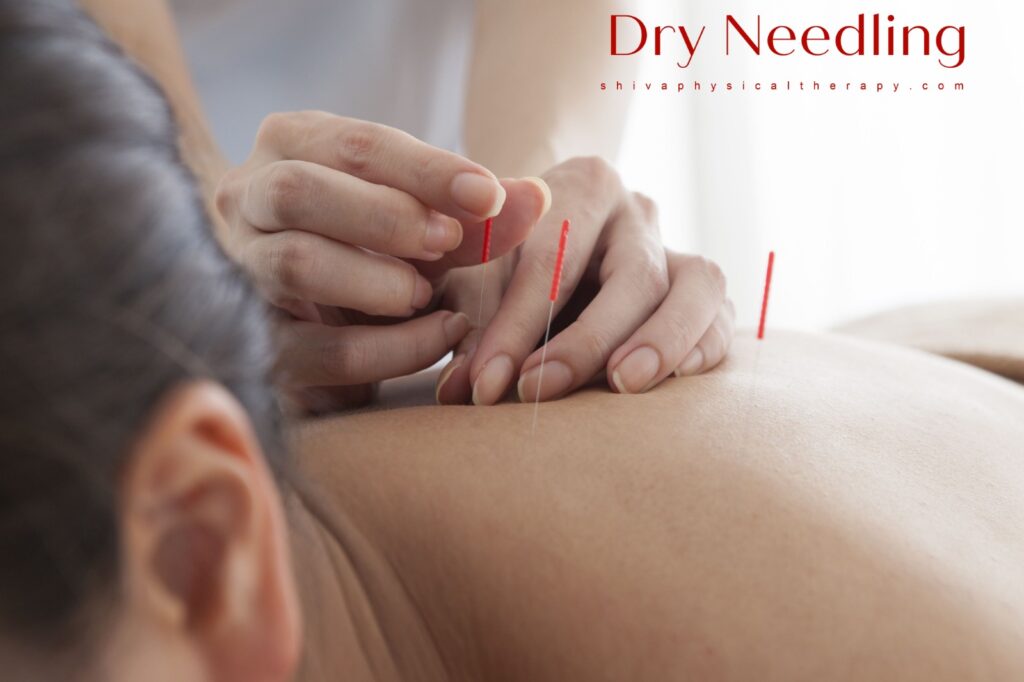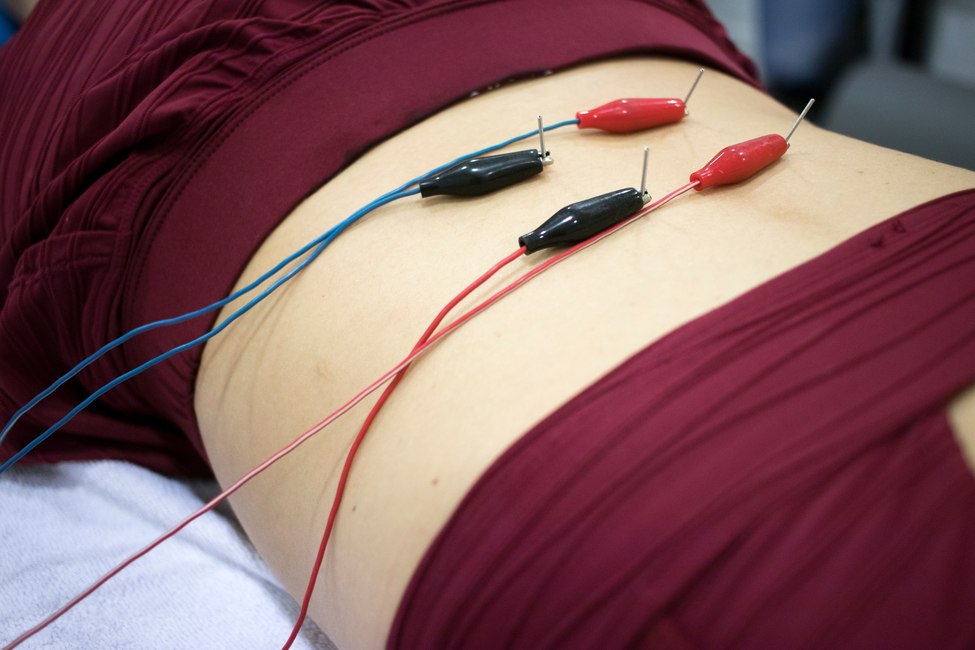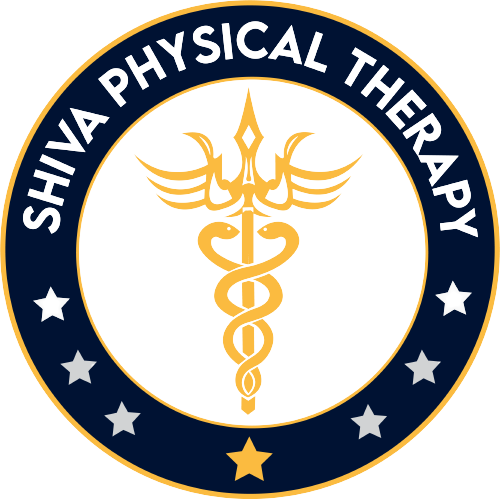What is Dry Needling?
Dry Needling is a form of therapy in which fine single-use needles are inserted into myofascial trigger points (painful knots in muscles), tendons, ligaments, or near nerves to stimulate a healing response in painful musculoskeletal conditions. It’s called Dry Needling because the needle is not hollow and isn’t injecting a fluid or medication. Dry Needling is not acupuncture or Oriental Medicine, and it doesn’t have the purpose of altering the flow of energy(“Q”). Dry Needling is a modern, science-based intervention for treating pain and dysfunction in musculoskeletal conditions using needles.

Dry Needling can have a wide range of effects on musculoskeletal systems, including mechanical, hypoalgesic (central, segmental, peripheral), neurophysiological, chemical, and hormonal effects on the human body. The outcome of the Dry Needling treatment depends on how the therapist utilizes the best available evidence-based treatment approaches in selecting the needling dose (i.e., frequency, intensity, and duration) and what conditions and reasons for the treatment are. Not all neuromusculoskeletal dysfunctions respond well to Dry Needling, and the treatment efficacy may vary with each patient.
Dry Needling can be a smooth process if performed by a well-trained therapist. The initial insertion of the needle does not usually cause much discomfort. After inserting a needle, a local twitch response may cause a brief painful reaction – some patients describe this as an electric shock or a cramping sensation. It is important to remember that the therapeutic effect only occurs by eliciting the twitch response; therefore, it is the desired reaction. The spinal reflex is responsible for the production of local twitch response; it was suggested that this would cause a change in nociceptive input and sensory-motor connection to produce analgesic effects in the muscle. Dry Needling is a safe and effective treatment and has excellent benefits in treating Musculoskeletal issues.
The Benefits of Dry Needling include:
- Reducing pain through increased Analgesic Effect through Biochemical mediation.
- Reducing Muscle Tension by relaxing the muscle.
- Improving Joint Mobility by relaxing surrounding muscles
- Eliminating Trigger Points by producing Biochemical and Biomechanical stimulation.
- Restoring Muscle Strength by stimulating cellular response, including cytoskeletal rearrangement and modulation of afferent sensory input by changing the connective tissue milieu.
- Improve potential downstream effects ( e.g., synthesis and local release of growth factors, cytokines, vasoactive substances, and structural matrix elements in surrounding connective cells .)
- Improve microcirculation and biomechanical response in the tissue for long-term healing.
- Likely to improve cell signaling, gene expression, and matrix adhesion and may also produce variable connective tissue tension to initiate long-term healing.
- Dry needling rotation can cause specific mechanical stimulation of subcutaneous connective tissue and tissue tensegrity.
What is Electro Dry Needling?
Electro Dry Needling is a modern technique in Dry Needling that utilizes an electro-stimulation to deliver electric currents through the needles to have additional effects through prolonged stimulation of nerves or muscles. The electro-Dry Needling works by blocking nerve pathways, preventing pain signals from traveling to the brain, and having an analgesic and anesthetic effect.

Electro Dry needling uses Low-frequency currents that are thought to improve the physiological effects by raising the endorphins release to help with pain relief than that obtained with standard dry Needling in patients. During Electro Dry Needling treatment, the patient may experience twitching, contractions, numbness, or tingling in the area being treated. The therapist consistently monitors the frequency and intensity to avoid pain or discomfort. Proper dosage should be considered when delivering electro-dry Needling as there is a wide range of parameters that can influence the efficacy of the treatment:
- Intensity (How strong the current should be)
- Pulse duration
- Frequency
- Stimulation duration and
- Size of the needles
The analgesic effects of electro-Dry Needling may be mediated by:
- Pain reception block by pain gait control theory.
- Elevating opioid peptides such as endorphins, enkephalins, serotonin, and acetylcholine in the central nervous system.
- Diffuse noxious inhibition control.
Electro Dry Needling is commonly used to treat Acute and Chronic neuromusculoskeletal pain conditions to get patients back to a pain-free and fulfilling life.
MSK Ultrasound Guided Dry Needling:
Musculoskeletal Ultrasound provides a real-time diagnosis and visualization by allowing accurate insight into the tissue and helps in needle placement for trigger points, tendinopathy, intramuscular pathology, and ligaments.
Even more significant evidence supports the use of ultrasound to guide Dry Needling treatments for improving treatment efficacy. Using ultrasound to visualize the needle has significantly enhanced the user’s accuracy in targeting the affected area compared to relying solely on palpation and anatomical landmarks. As a result, this can improve outcomes related to pain and function, as the affected area is consistently and accurately getting the treatment needed.
Dry Needling has proven to have beneficial effects in treating the following condition, but not limited to:
- Back or neck pain
- Headaches and migraines
- Joint problems and pain
- Myofascial pain
- Pelvic pain
- Piriformis syndrome
- Gluteal tendinopathy
- Hip Muscle Pain
- Trochanteric bursitis
- Adductor tendinopathy syndrome
- Iliotibial band syndrome (IT band syndrome)
- Psoas or iliopsoas tendinopathy
- Patellofemoral pain syndrome (Runner’s Knee )
- Patellar tendinopathy
- Achilles tendinopathy (Heel Pain)
- Peroneal tendinopathy
- Frozen Shoulders (Adhesive capsulitis of shoulder)
- Rotator cuff tear
- Tendinitis of the shoulder
- Knee Pain
- Lateral epicondylopathy of the elbow (Tennis Elbow)
- Medial epicondylopathy of the elbow (Golfers Elbow)
- Bicep tendonitis
- Posterior interosseous nerve (PIN)
- Cubital tunnel syndrome
- Pronator syndrome (PS)
- Fibromyalgia
- Chronic pain
- Shin splints
- Plantar fasciitis
- TMJ
- Tendonitis
- Trigger points
- Whiplash
Side effects or Adverse events in Dry Needling:
Electro Dry needling is contraindicated in patients with cardiac pacemakers or other electric implants, pregnant women, or trying to get pregnant. Dry Needling is contraindicated in patients with bleeding disorders, and other general Dry Needling contraindications may apply. Drowsiness, tiredness, or dizziness occurs after treatment in a small number of patients (1-3%). In 0.3% of patients, fainting has been reported, but this can be avoided by taking a good history and avoiding Needling on patient who fears needles. Minor bleeding or bruising occurs after Dry Needling in 15-20% of treatments. Temporary pain during Dry Needling occurs in 60-70% of treatments. Other adverse effects can be pneumothorax and injury to the peripheral nerves and blood vessels. All this can be avoided if the therapist has good anatomical knowledge and completes a proper evaluation.
Dry Needling should be given at least the first treatment in prone, side-laying, or supine may not be in sitting as Dry Needling has been found to elicit transient changes in blood pressure and sometimes can cause a Vaso-vagal response in some patients.
Talk to your therapist or the Doctor about the Dry Needling treatment options and see what kind of Dry Needling will fit your treatment plan to get the help you need to recover faster without injections and surgery.
Dr. Siva Parnam, DPT, Osteopractor
References
- Fernández-de-Las-Peñas C, Nijs J. Trigger point dry Needling for the treatment of myofascial pain syndrome: current perspectives within a pain neuroscience paradigm. J Pain Res. 2019 Jun 18;12:1899-1911. doi: 10.2147/JPR.S154728. PMID: 31354339; PMCID: PMC6590623.
- Eftekharsadat B, Babaei-Ghazani A, Zeinolabedinzadeh V. Dry needling in patients with chronic heel pain due to plantar fasciitis: A single-blinded randomized clinical trial. Med J Islam Repub Iran. 2016 Jul 23;30:401. PMID: 27683642; PMCID: PMC5038993.
- Gerber LH, Sikdar S, Aredo JV, Armstrong K, Rosenberger WF, Shao H, Shah JP. Beneficial Effects of Dry Needling for Treatment of Chronic Myofascial Pain Persist for 6 Weeks After Treatment Completion. PM R. 2017 Feb;9(2):105-112. doi: 10.1016/j.pmrj.2016.06.006. Epub 2016 Jun 11. PMID: 27297448; PMCID: PMC5149452
- Lara-Palomo IC, Gil-Martínez E, Antequera-Soler E, Castro-Sánchez AM, Fernández-Sánchez M, García-López H. Electrical dry needling versus conventional physiotherapy in the treatment of active and latent myofascial trigger points in patients with nonspecific chronic low back pain. Trials. 2022 Mar 28;23(1):238. doi: 10.1186/s13063-022-06179-y. PMID: 35346331; PMCID: PMC8961901.
- Dunning J, Butts R, Mourad F, Young I, Flannagan S, Perreault T. Dry needling: a literature review with implications for clinical practice guidelines. Phys Ther Rev. 2014 Aug;19(4):252-265. doi: 10.1179/108331913X13844245102034. PMID: 25143704; PMCID: PMC4117383.
- Vas LC. Ultrasound-guided dry Needling: Relevance in chronic pain. J Postgrad Med. 2022 Jan-Mar;68(1):1-9. doi: 10.4103/jpgm.jpgm_710_21. PMID: 35073681; PMCID: PMC8860112.

